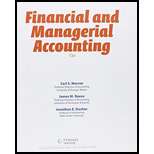
Bundle: Financial & Managerial Accounting, Loose-Leaf Version, 13th + CengageNOWv2, 2 terms Printed Access Card
13th Edition
ISBN: 9781305516717
Author: Carl Warren, James M. Reeve, Jonathan Duchac
Publisher: Cengage Learning
expand_more
expand_more
format_list_bulleted
Question
Chapter 13, Problem 1DQ
To determine
Investment:
The act of allocating money to buy a monetary asset, in order to generate wealth in the future is referred to as investment.
To explain: The reasons a business invests in temporary investments.
Expert Solution & Answer
Explanation of Solution
A business invests in temporary investments for the following reasons:
- To earn interest revenue from bond investments
- To earn dividend revenue from stock investments
- To recognize gain from investments, when the market price of the investment rises
Want to see more full solutions like this?
Subscribe now to access step-by-step solutions to millions of textbook problems written by subject matter experts!
Students have asked these similar questions
Please provide answer this general accounting question
General Accounting
Financial Accounting
Chapter 13 Solutions
Bundle: Financial & Managerial Accounting, Loose-Leaf Version, 13th + CengageNOWv2, 2 terms Printed Access Card
Ch. 13 - Prob. 1DQCh. 13 - What causes a gain or loss on the sale of a bond...Ch. 13 - Prob. 3DQCh. 13 - Prob. 4DQCh. 13 - Prob. 5DQCh. 13 - Prob. 6DQCh. 13 - Prob. 7DQCh. 13 - Prob. 8DQCh. 13 - What are the factors contributing to the trend...Ch. 13 - Prob. 10DQ
Ch. 13 - Prob. 1APECh. 13 - Bond investment transactions Journalize the...Ch. 13 - Prob. 2APECh. 13 - Stock investment transactions On September 12,...Ch. 13 - Prob. 3APECh. 13 - Prob. 3BPECh. 13 - Prob. 4APECh. 13 - Prob. 4BPECh. 13 - Prob. 5APECh. 13 - Prob. 5BPECh. 13 - Prob. 6APECh. 13 - Prob. 6BPECh. 13 - Prob. 1EXCh. 13 - Prob. 2EXCh. 13 - Prob. 3EXCh. 13 - Prob. 4EXCh. 13 - Prob. 5EXCh. 13 - Entries for investment in stock, receipt of...Ch. 13 - Prob. 7EXCh. 13 - Prob. 8EXCh. 13 - Entries for stock investments, dividends, and sale...Ch. 13 - Prob. 10EXCh. 13 - Prob. 11EXCh. 13 - Prob. 12EXCh. 13 - Prob. 13EXCh. 13 - Prob. 14EXCh. 13 - Prob. 15EXCh. 13 - Prob. 16EXCh. 13 - Fair value journal entries, trading investments...Ch. 13 - Prob. 18EXCh. 13 - Prob. 19EXCh. 13 - Prob. 20EXCh. 13 - Prob. 21EXCh. 13 - Prob. 22EXCh. 13 - Prob. 23EXCh. 13 - Prob. 24EXCh. 13 - Prob. 25EXCh. 13 - Prob. 26EXCh. 13 - Prob. 27EXCh. 13 - Prob. 28EXCh. 13 - Prob. 29EXCh. 13 - Debt investment transactions, available-for-sale...Ch. 13 - Prob. 2APRCh. 13 - Stock investment transactions, equity method and...Ch. 13 - Prob. 4APRCh. 13 - Prob. 1BPRCh. 13 - Prob. 2BPRCh. 13 - Stock investment transactions, equity method and...Ch. 13 - Prob. 4BPRCh. 13 - Selected transactions completed by Equinox...Ch. 13 - Benefits of fair value On July 16, 1998, Wyatt...Ch. 13 - Prob. 2CPCh. 13 - Prob. 3CPCh. 13 - Prob. 4CP
Knowledge Booster
Learn more about
Need a deep-dive on the concept behind this application? Look no further. Learn more about this topic, accounting and related others by exploring similar questions and additional content below.Similar questions
arrow_back_ios
SEE MORE QUESTIONS
arrow_forward_ios
Recommended textbooks for you
- Principles of Accounting Volume 1AccountingISBN:9781947172685Author:OpenStaxPublisher:OpenStax CollegeCentury 21 Accounting Multicolumn JournalAccountingISBN:9781337679503Author:GilbertsonPublisher:Cengage
 Cornerstones of Financial AccountingAccountingISBN:9781337690881Author:Jay Rich, Jeff JonesPublisher:Cengage Learning
Cornerstones of Financial AccountingAccountingISBN:9781337690881Author:Jay Rich, Jeff JonesPublisher:Cengage Learning Intermediate Accounting: Reporting And AnalysisAccountingISBN:9781337788281Author:James M. Wahlen, Jefferson P. Jones, Donald PagachPublisher:Cengage Learning
Intermediate Accounting: Reporting And AnalysisAccountingISBN:9781337788281Author:James M. Wahlen, Jefferson P. Jones, Donald PagachPublisher:Cengage Learning

Principles of Accounting Volume 1
Accounting
ISBN:9781947172685
Author:OpenStax
Publisher:OpenStax College

Century 21 Accounting Multicolumn Journal
Accounting
ISBN:9781337679503
Author:Gilbertson
Publisher:Cengage


Cornerstones of Financial Accounting
Accounting
ISBN:9781337690881
Author:Jay Rich, Jeff Jones
Publisher:Cengage Learning

Intermediate Accounting: Reporting And Analysis
Accounting
ISBN:9781337788281
Author:James M. Wahlen, Jefferson P. Jones, Donald Pagach
Publisher:Cengage Learning

How to build an investment portfolio; Author: The Finance Storyteller;https://www.youtube.com/watch?v=K4mWd2zBYVk;License: Standard Youtube License